Author: Chris
Recently, the project made an exciting discovery. A collection of cremated remains from a cist burial at Staarvey Farm, German, that was excavated in 1947 has been curated at the museum ever since, and was examined in close detail by Michelle Gamble earlier this Autumn. As an osteoarchaeologist, Michelle’s task is to assess the human remains (check out her blog on this topic), but as she prepared these for analysis she realised that some of the bone was not human and was in fact worked into artefacts. After carefully measuring and photographing these objects Michelle emailed the images to Rachel and myself. I opened my email to find a photograph of a rare Bronze Age object – a bone pommel from a bronze knife or dagger! This would have been fitted to the very end of the knife hilt. Less than 40 of these have been recorded from the British Isles, and none have been found on the Isle of Man before – so this is a very exciting discovery. And since then I have been looking at the photographs of these objects and pouring over books and articles listing the details of burials that included similar artefacts to that found at Staarvey Farm. This blog outlines some of what we can learn from this research process, along with the osteological analysis that Michelle has carried out.
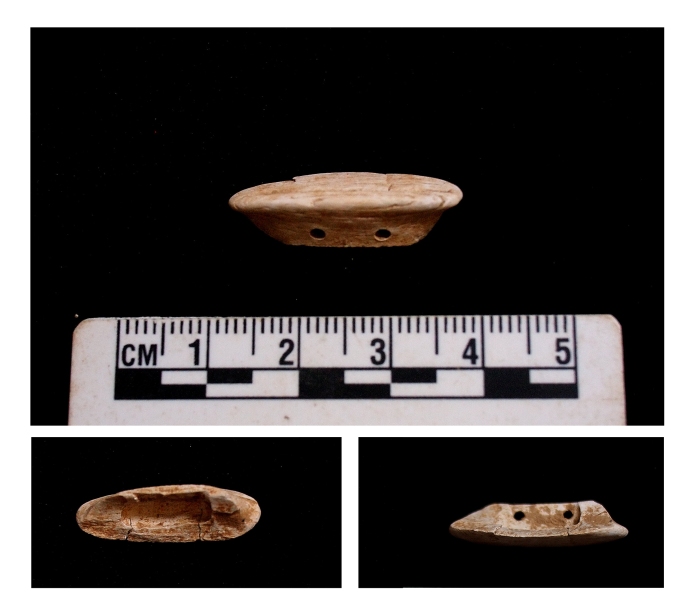
Stuart Needham (now retired from his post as Keeper of Bronze Age collections at the British Museum) devised a new typology of dagger pommels which was published last year. A typology is a system of classification which groups together objects with similar characteristics – just as you can probably tell from looking at somebody’s mobile phone how old it is and what it can do, so archaeologists group artefacts into types or classes to consider what they have in common and how they differ. The Staarvey Farm pommel has an oval shape, an elliptical socket, and the profile flares outwards from the socket. This makes it a class 3 pommel in Needham’s typology. About half of all the Early Bronze Age dagger and knife pommels known belong to this group. Another 19 class 3 pommels, sharing the same traits, are currently known, and 10 of those were buried with a Collared Urn, the same type of vessel found in the Staarvey Farm cist.
When archaeologists put objects into types and classes they usually adopt the working premise that the most similar objects are likely to be contemporary. This premise can be tested, particularly using radiocarbon dating. Four burials with class 3 dagger pommels have been dated previously, with most results placing them between c. 2000 BC and 1700 BC. At Staarvey Farm, some of the cremated bone was radiocarbon dated in the late 1990s, giving a result that places the burial some time between 1956-1695 cal BC. At present it is hard to say whether this type of pommel was current for only a short period within these centuries. It is also possible that some pommels or blades were kept for long periods of time (e.g. passed on as heirlooms), and the buried examples were already old when they were buried. Needham’s typology of pommels referred to above was written as part of a much larger of Early Bronze Age grave goods directed by Ann Woodward and John Hunter (you can find the book details at the end of this blog), and another part of that study involved assessing the traces of wear on objects. Some objects were relatively new and unworn when buried, others much more worn or showing signs of damage and repair. The study of the wear marks on 19 pommels (of various classes) suggests they were heavily worn before burial. Furthermore, many of the class 3 pommels were broken as well as burnt and it is possible they were detached from the hilt and blade before being placed on the funeral pyre. This may perhaps have been part of a funerary ritual – a metaphor for loss and death, perhaps? – and may also suggest that the bronze blade was retained for use by others.
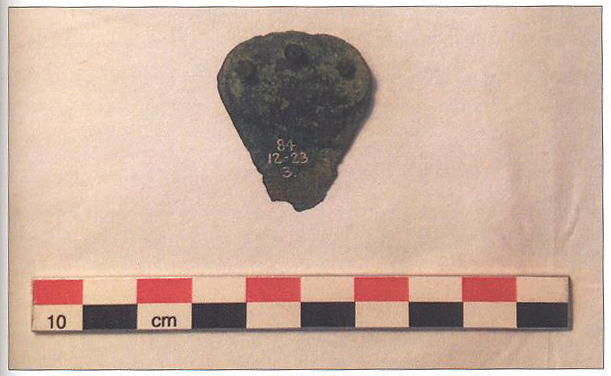
Bronze blades have been found more frequently in Early Bronze Age burials than pommels. Those blades can be categorised into many different types, but I want to highlight just one distinction among them – that between longer dagger blades and shorter blades referred to as ‘knife-daggers’. There are a fair number of dagger burials with the remains of bodies that were not cremated, and many of these date from c. 2250-2000 BC. In the majority of cases these were buried with adult men, suggesting they had a specific gendered and age-related significance. However, knife-daggers have been found buried with women as well as men, and seem to have become more common after c. 2000 BC. To some extent a distinction based on length of the blade may seem an arbitrary one, but Needham’s research on class 3 dagger pommels suggests that the smaller pommels were fitted to the smaller blades. Since our pommel from Staarvey Farm is one of the smallest, it seems likely it was the hilt of a small knife-dagger.
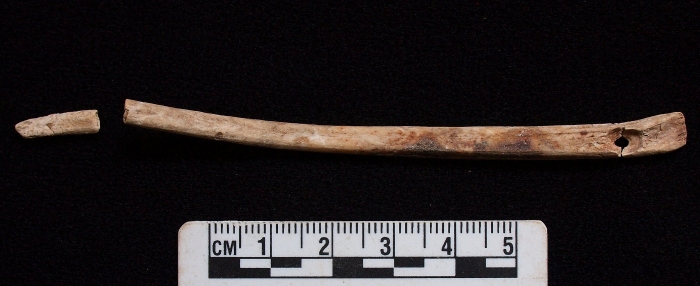
Michelle had sent photos of several other objects she found too. One is a bone pin, about 10cm long and slightly burnt. Specialists on Early Bronze Age objects have distinguished dress pins from another class of similar object which they refer to as bone points. The Staarvey Farm pin falls under the category of a bone point. Such points were probably not tools, as the name might suggest, however. About three quarters of the bone points examined in Woodward and Hunter’s project showed little or no evidence of wear on the tip, as might be expected if the point was used as a tool. Some of these points showed light wear around the perforation of a kind suggesting they were stitched onto a garment or head-covering, and a number that have been found with burials of remains that were not cremated were positioned close to the head. They were largely found in female graves. A next step for our project will be to examine the Staarvey Farm pommel, point, and other bone objects under magnification for signs of wear.
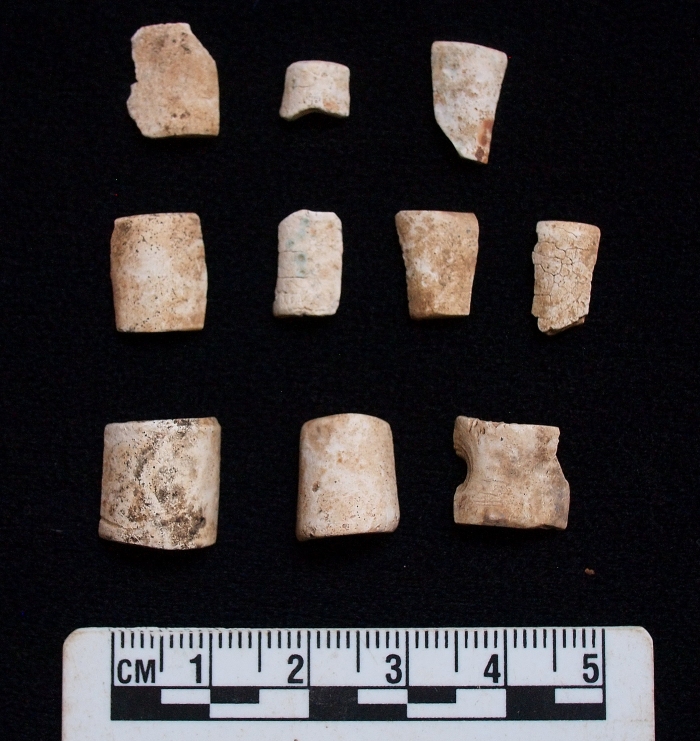
The remains also included a set of what appear to be beads made from bird bones. These have been heavily fragmented during the cremation process, and need closer examination before we can say much more about them. Necklaces are fairly common in Early Bronze Age burials, particularly but not exclusively with female burials, and again there are many different types of beads which changed over time. Placement of necklaces comprising jet, amber and/or bone beads was also a feature of several burials with class 3 dagger or knife-dagger pommels – in some cases these had been through the funerary pyre but in other cases they seem to have been added to the cremated remains after those were collected for burial or placed in the burial pit next to the urn containing the cremated remains. The beads at Staarvey Farm were burnt, and along with the pommel and probably the bone point we can infer that at all of these objects were either worn on the bodies of the dead or were placed with them on the funeral pyre by mourners.
The last group of objects consists of four enigmatic, burnt, slightly curved, bone plates, strips or plaques. These are very intriguing and we don’t yet know how to interpret them. In part this is because we have not been able to find any similar examples in the archaeological literature we have searched so far. We had various guesses, but need to examine them more closely and think about some experiments we could do with replicas in to see if any of those ideas hold water. Unfortunately I haven’t yet seen any of the bone objects first hand myself – I can’t wait to see them on my next trip! – and its hard to really understand an object without handling it. But I’ve chatted to Michelle, and we have thought about whether they could have been armatures fitted in tools, used for finishing or decorating pottery, might have been incomplete ‘spacer plates’ for a necklace, or might have been sewn into garments to provide shape (like the plastic tags in my shirt collars) – the answer to all of these guesses is ‘probably not’, but we need to come up with ideas like this and then think about ways to test them.
Next steps include assessing the wear traces on all of these objects, and for a specialist on artefacts made from animal bone to examine the bone objects to see if it is possible to tell which bones from which species of animal were used to make these artefacts. This is particularly important in the case of the pommel because some pommels were made from cetacean bone – that is, bone from whales, dolphins or porpoises. These are large and impressive animals, living in the depths of the sea, and they may have had a specific place in prehistoric folklore.
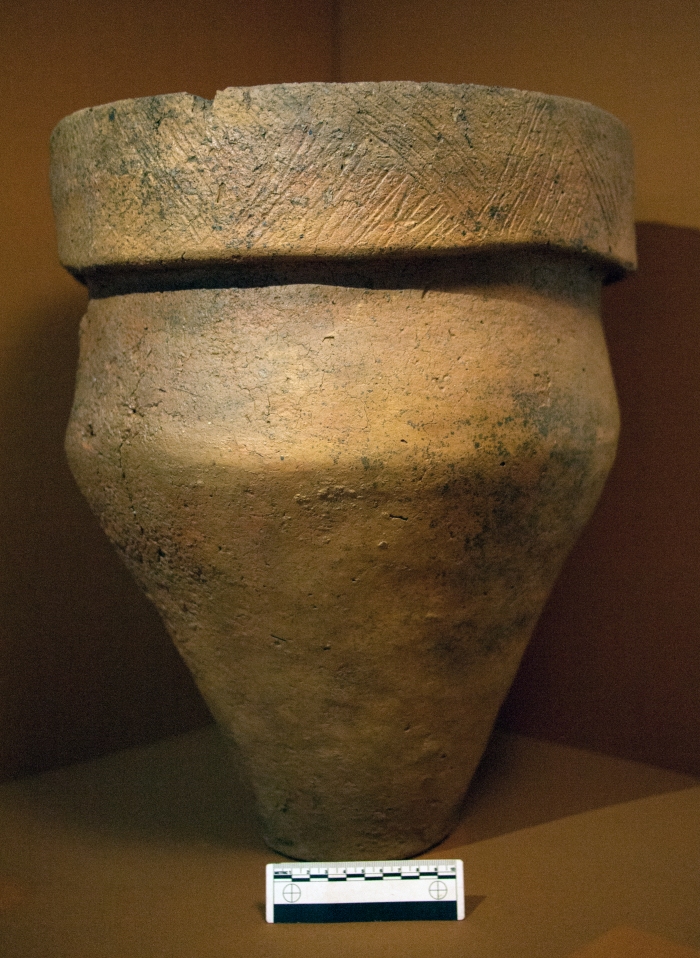
Aside from the newly-discovered bone objects, a set of durable artefacts were also found in the cist, including a flint knife and a flint scraper and two ceramic vessels. These have been precisely described and identified by Jenny Woodcock, who produced the definitive publication on the Staarvey Farm excavation based on the excavator’s notes and a re-examination of the objects in the museum collection (the bones were not re-examined at that time). The knife is of a type known as plano-convex knives, which were often associated with burials after around 2100 BC. The scraper was a tool for separating the fat from the insides of animal hides (though these may have had other uses besides). Collared Urns were widespread throughout the British Isles, very commonly found containing cremated bones. An important summary of all the known examples at the time was published by Ian Longworth in 1984, and lists over 2200 examples, including the better preserved vessel from Staarvey Farm. It was buried upside down in the cist, and its rim was surrounded by a ring of pebbles, all but one of which was quartz. Urns like this were often buried upside down (‘inverted’ – see Rachel’s earlier blog), and the placement of a stone slab at the mouth of the vessel or of stones around the rim was a recurring motif. A second pot was found in the cist too, but it was badly damaged and the neck and rim only survive as small fragments, some of which Michelle found among the cremated bone. Further work is needed to identify what type of pot it was, though it may well also be a Collared Urn.
Something I am working on at the moment is comparing the Staarvey Farm burial with another 50 or so burials of Collared Urns in cists across the British Isles. Some of these burials share similarities that suggest shared funerary practices which may also denote shared spheres of interaction. To give an example, one of the most similar burials to Staarvey Farm comes from a large ring cairn in Anglesey called Bedd Branwen. This monument housed multiple Early Bronze Age burials, two of which included bone pommels very similar to that from Staarvey Farm, and one of those was in an inverted Collared Urn in a cist. The bones were from a male adult who suffered from osteoarthritis, and a burnt bone bead and the burnt bone pommel were found among them. At the mouth of the pot, which was inverted, were a set of unburnt beads (6 in amber and four in jet) – were these a gift from one or more mourners, included after the bones were collected from the funeral pyre? This burial has been radiocarbon dated to sometime within the same centuries as the radiocarbon date from Staarvey Farm (though the date was taken from charcoal which can be less accurate and radiocarbon dating techniques have changed since this was done in the 1960s). Comparing similarities and differences between burials of the same period is an important step in thinking about the scale and extent of past social networks, about different experiences of funerals, and many other issues (there will be another blog on this shortly!).
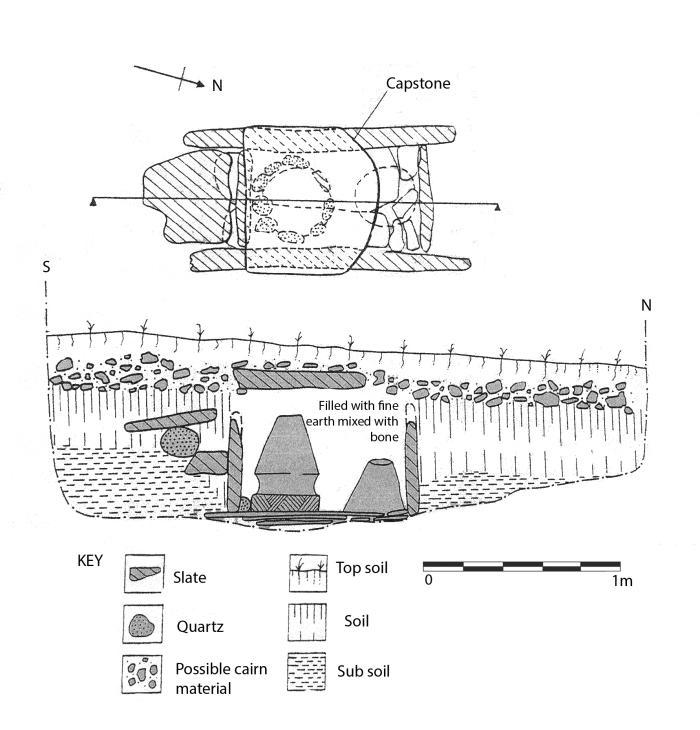
So who was buried with these objects? Michelle’s analysis of the human remains from Staarvey Farm has established that cremated bone from at least four individuals were buried in the cist. Two are adults, one an adolescent and one child, possibly very young. It is not possible to determine the sex of these people from their cremated bones using standard osteological analysis. Unfortunately, due to how the site was located and excavated it is not possible to say whether the remains of one or more of these individuals was placed in the Collared Urn or second vessel, nor whether the pommel and other bone objects were buried in or with either of the vessels. We also do not know if we are looking at the remains of a single event of burial, in which the remains of four people were buried at once, or during two or more burial events with the later ones re-opening the cist. We do not know which objects were associated with which individuals, or how many cremation events took place – it is possible that there was one cremation pyre for four bodies, or four separate pyres, or somewhere in between. It is possible that the cremated remains from one funeral pyre were stored for some time before other remains were added, and that burial was much later than that first funeral. It may not be possible to resolve these uncertainties given the records that we have from an excavation over 60 years ago. This is why carrying out new excavations is so important in archaeology – we would excavate and record a site like this differently now to the practices in the 1940s, use new techniques and technologies, and treat the recovered remains in different ways.
There is a lot more we could say about this burial and other burials we can compare it with, but there is also a lot more work to do before we can say anything with more certainty – so I’ll leave it here and hopefully will follow this up with another blog next year. If you would like to read more about the Staarvey Farm burial, the best source is:
Woodcock, J.J. 1999. A report on the excavation carried out by B.R.S. Megaw at Staarvey Farm, Kirk German, in P.J. Davey (ed.) Recent Archaeological Research on the Isle of Man. British Archaeological Reports, British Series 278, 89-98.
There is nothing to see at the find location, which is on private land.
The book referred to above on Early Bronze Age objects from graves is Woodward, A. & Hunter, J. with Bukach, D., Needham, S. & Sheridan, J.A. (eds) 2015. Ritual in Early Bronze Age grave goods: an examination of ritual and dress equipment from Chalcolithic and Early Bronze Age graves in England. Oxford: Oxbow Books.


Fascinating!
LikeLike